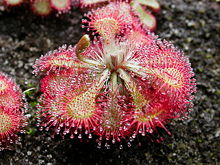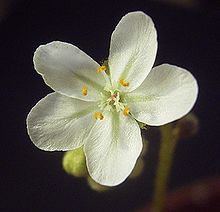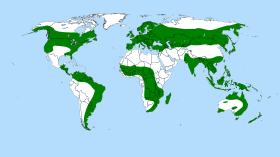A | B | C | D | E | F | G | H | CH | I | J | K | L | M | N | O | P | Q | R | S | T | U | V | W | X | Y | Z | 0 | 1 | 2 | 3 | 4 | 5 | 6 | 7 | 8 | 9
| Drosera | |
|---|---|

| |
| Drosera tokaiensis | |
| Scientific classification | |
| Kingdom: | Plantae |
| Clade: | Tracheophytes |
| Clade: | Angiosperms |
| Clade: | Eudicots |
| Order: | Caryophyllales |
| Family: | Droseraceae |
| Genus: | Drosera L. |
| Subgenera | |
| Synonyms[1] | |
| |
Drosera, which is commonly known as the sundews, is one of the largest genera of carnivorous plants, with at least 194 species.[2] These members of the family Droseraceae[1] lure, capture, and digest insects using stalked mucilaginous glands covering their leaf surfaces. The insects are used to supplement the poor mineral nutrition of the soil in which the plants grow. Various species, which vary greatly in size and form, are native to every continent except Antarctica.[3]
Charles Darwin performed much of the early research into Drosera, engaging in a long series of experiments with Drosera rotundifolia which were the first to confirm carnivory in plants.[4][5][6] In an 1860 letter, Darwin wrote, “…at the present moment, I care more about Drosera than the origin of all the species in the world.”[7]
Taxonomy
The botanical name from the Greek δρόσος drosos "dew, dewdrops"[8] refer to the glistening drops of mucilage at the tip of the glandular trichomes that resemble drops of morning dew. The English common name sundew also describes this, derived from Latin ros solis meaning "dew of the sun".
The Principia Botanica, published in 1787, states “Sun-dew (Drosera) derives its name from small drops of a liquor-like dew, hanging on its fringed leaves, and continuing in the hottest part of the day, exposed to the sun.”[9]
Phylogenetics
|
The unrooted cladogram to the right shows the relationship between various subgenera and classes as defined by the analysis of Rivadavia et al.[10] The monotypic section Meristocaulis was not included in the study, so its place in this system is unclear. More recent studies have placed this group near section Bryastrum, so it is placed there below. Also of note, the placement of the section Regiae in relation to Aldrovanda and Dionaea is uncertain. Since the section Drosera is polyphyletic, it shows up multiple times in the cladogram (*).
This phylogenetic study has made the need for a revision of the genus even clearer.
Description

Sundews are perennial (or rarely annual) herbaceous plants, forming prostrate or upright rosettes between 1 and 100 cm (0.39 and 39.37 in) in height, depending on the species. Climbing species form scrambling stems which can reach much longer lengths, up to 3 m (9.8 ft) in the case of D. erythrogyne.[11] Sundews have been shown to be able to achieve a lifespan of 50 years.[12]: 102 The genus is specialized for nutrient uptake through its carnivorous behavior, for example the pygmy sundew is missing the enzymes (nitrate reductase, in particular)[13] that plants normally use for the uptake of earth-bound nitrates.
Habit
The genus can be divided into several habits, or growth forms:
- Temperate sundews: These species form a tight cluster of unfurled leaves called a hibernaculum in a winter dormancy period (= Hemicryptophyte). All of the North American and European species belong to this group. Drosera arcturi from Australia (including Tasmania) and New Zealand is another temperate species that dies back to a horn-shaped hibernaculum.
- Subtropical sundews: These species maintain vegetative growth year-round under uniform or nearly uniform climatic conditions.
- Pygmy sundews: A group of roughly 40 Australian species, they are distinguished by miniature growth, the formation of gemmae for asexual reproduction, and dense formation of hairs in the crown center. These hairs serve to protect the plants from Australia's intense summer sun. Pygmy sundews form the subgenus Bryastrum.
- Tuberous sundews: These nearly 50 Australian species form an underground tuber to survive the extremely dry summers of their habitat, re-emerging in the autumn. These so-called tuberous sundews can be further divided into two groups, those that form rosettes and those that form climbing or scrambling stems. Tuberous sundews comprise the subgenus Ergaleium.

- Petiolaris complex: A group of tropical Australian species, they live in constantly warm but sometimes wet conditions. Several of the 14 species that comprise this group have developed special strategies to cope with the alternately drier conditions. Many species, for example, have petioles densely covered in trichomes, which maintain a sufficiently humid environment and serve as an increased condensation surface for morning dew. The Petiolaris complex comprises the subgenus Lasiocephala.
Although they do not form a single strictly defined growth form, a number of species are often put together in a further group:
- Queensland sundews: A small group of three species (D. adelae, D. schizandra and D. prolifera), all are native to highly humid habitats in the dim understories of the Australian rainforest.
Leaves and carnivory

Sundews are characterised by the glandular tentacles, topped with sticky secretions, that cover their leaves. The trapping and digestion mechanism usually employs two types of glands: stalked glands that secrete sweet mucilage to attract and ensnare insects and enzymes to digest them, and sessile glands that absorb the resulting nutrient soup (the latter glands are missing in some species, such as D. erythrorhiza). Small prey, mainly consisting of insects, are attracted by the sweet secretions of the peduncular glands. Upon touching these, the prey become entrapped by sticky mucilage which prevents their progress or escape. Eventually, the prey either succumb to death through exhaustion or through asphyxiation as the mucilage envelops them and clogs their spiracles. Death usually occurs within 15 minutes.[6] The plant meanwhile secretes esterase, peroxidase, phosphatase and protease enzymes.[12]: 41 These enzymes dissolve the insect and free the nutrients contained within it. This nutrient mixture is then absorbed through the leaf surfaces to be used by the rest of the plant.

All species of sundew are able to move their tentacles in response to contact with edible prey. The tentacles are extremely sensitive and will bend toward the center of the leaf to bring the insect into contact with as many stalked glands as possible. According to Charles Darwin, the contact of the legs of a small gnat with a single tentacle is enough to induce this response.[6] This response to touch is known as thigmonasty, and is quite rapid in some species. The outer tentacles (recently coined as "snap-tentacles") of D. burmannii and D. sessilifolia can bend inwards toward prey in a matter of seconds after contact, while D. glanduligera is known to bend these tentacles in toward prey in tenths of a second.[14] In addition to tentacle movement, some species are able to bend their leaves to various degrees to maximize contact with the prey. Of these, D. capensis exhibits what is probably the most dramatic movement, curling its leaf completely around prey in 30 minutes. Some species, such as D. filiformis, are unable to bend their leaves in response to prey.[15]

A further type of (mostly strong red and yellow) leaf coloration has recently been discovered in a few Australian species (D. hartmeyerorum, D. indica). Their function is not known yet, although they may help in attracting prey.
The leaf morphology of the species within the genus is extremely varied, ranging from the sessile ovate leaves of D. erythrorhiza to the bipinnately divided acicular leaves of D. binata.
While the exact physiological mechanism of the sundew's carnivorous response is not yet known, some studies have begun to shed light on how the plant is able to move in response to mechanical and chemical stimulation to envelop and digest prey. Individual tentacles, when mechanically stimulated, fire action potentials that terminate near the base of the tentacle, resulting in rapid movement of the tentacle towards the center of the leaf.[16][17] This response is more prominent when marginal tentacles further away from the leaf center are stimulated. The tentacle movement response is achieved through auxin-mediated acid growth. When action potentials reach their target cells, the plant hormone auxin causes protons (H+ ions) to be pumped out of the plasma membrane into the cell wall, thereby reducing the pH and making the cell wall more acidic.[18] The resulting reduction in pH causes the relaxation of the cell wall protein, expansin, and allows for an increase in cell volume via osmosis and turgor. As a result of differential cell growth rates, the sundew tentacles are able to achieve movement towards prey and the leaf center through the bending caused by expanding cells.[19] Among some drosera species, a second bending response occurs in which non-local, distant tentacles bend towards prey as well as the bending of the entire leaf blade to maximize contact with prey. While mechanical stimulation is sufficient to achieve a localized tentacle bend response, both mechanical and chemical stimuli are required for the secondary bending response to occur.[20]
Flowers and fruit

The flowers of sundews, as with nearly all carnivorous plants, are held far above the leaves by a long stem. This physical isolation of the flower from the traps is commonly thought to be an adaptation meant to avoid trapping potential pollinators. The mostly unforked inflorescences are spikes, whose flowers open one at a time and usually only remain open for a short period. Flowers open in response to light intensity (often opening only in direct sunlight), and the entire inflorescence is also heliotropic, moving in response to the sun's position in the sky.

The radially symmetrical (actinomorphic) flowers are always perfect and have five parts (the exceptions to this rule are the four-petaled D. pygmaea and the eight to 12-petaled D. heterophylla). Most of the species have small flowers (<1.5 cm or 0.6 in). A few species, however, such as D. regia and D. cistiflora, have flowers 4 cm (1.6 in) or more in diameter.[15] In general, the flowers are white or pink. Australian species display a wider range of colors, including orange (D. callistos), red (D. adelae), yellow (D. zigzagia) or metallic violet (D. microphylla).
The ovary is superior and develops into a dehiscent seed capsule bearing numerous tiny seeds. The pollen grain type is compound, which means four microspores (pollen grains) are stuck together with a protein called callose.[citation needed]
Roots

The root systems of most Drosera are often only weakly developed or have lost their original functions.[21] They are relatively useless for nutrient uptake, and they serve mainly to absorb water and to anchor the plant to the ground; they have long hairs.[21]
A few South African species use their roots for water and food storage. Some species have wiry root systems that remain during frosts if the stem dies. Some species, such as D. adelae and D. hamiltonii, use their roots for asexual propagation, by sprouting plantlets along their length. Some Australian species form underground corms for this purpose, which also serve to allow the plants to survive dry summers. The roots of pygmy sundews are often extremely long in proportion to their size, with a 1-cm (0.4-in) plant extending roots over 15 cm (5.9 in) beneath the soil surface. Some pygmy sundews, such as D. lasiantha and D. scorpioides, also form adventitious roots as supports.
D. intermedia and D. rotundifolia have been reported to form arbuscular mycorrhizae, which penetrate the plant's tissues,[22] they also host fungi like endophytes to collect nutrients when they grow in poor soil and form symbiotic relationships.[23]
Reproduction
Many species of sundews are self-fertile; their flowers will often self-pollinate upon closing. Often, numerous seeds are produced. The tiny black seeds germinate in response to moisture and light, while seeds of temperate species also require cold, damp, stratification to germinate. Seeds of the tuberous species require a hot, dry summer period followed by a cool, moist winter to germinate.
Vegetative reproduction occurs naturally in some species that produce stolons or when roots come close to the surface of the soil. Older leaves that touch the ground may sprout plantlets. Pygmy sundews reproduce asexually using specialized scale-like leaves called gemmae. Tuberous sundews can produce offsets from their corms.[15]
In culture, sundews can often be propagated through leaf, crown, or root cuttings, as well as through seeds.[15]
Distribution


>Text je dostupný pod licencí Creative Commons Uveďte autora – Zachovejte licenci, případně za dalších podmínek. Podrobnosti naleznete na stránce Podmínky užití.
Sundew (disambiguation)
File:Drosera spatulata KansaiHabit.jpg
Drosera tokaiensis
Taxonomy (biology)
Template:Taxonomy/Drosera
Plant
Vascular plant
Flowering plant
Eudicots
Caryophyllales
Droseraceae
Carl Linnaeus
Drosera subg. Coelophylla
Drosera subg. Ergaleium
Drosera subg. Lasiocephala
Drosera subg. Meristocaulis
Drosera subg. Phycopsis
Drosera subg. Regiae
Drosera subg. Stelogyne
Drosera subg. Thelocalyx
Synonym (taxonomy)
Genus
Carnivorous plant
Species
Droseraceae
Mucilage
Antarctica
Charles Darwin
Drosera rotundifolia
Ancient Greek
Mucilage
Trichome
Dew
Latin
Taxonomy of Drosera
List of Drosera species
Drosera sect. Drosera
Drosera sect. Thelocalyx
Drosera subg. Ergaleium
Drosera subg. Phycopsis
Drosera sect. Bryastrum
Drosera sect. Lamprolepis
Drosera sect. Lasiocephala
Drosera sect. Coelophylla
Drosera arcturi
Drosera regia
Aldrovanda
Venus flytrap
Cladogram
Polyphyletic
File:DroseraZonariaTuber2-.jpg
Drosera zonaria
Perennial plant
Annual plant
Herbaceous plant
Drosera erythrogyne
Nutrient
Enzyme
Nitrate reductase
Habit (biology)
Hibernaculum (botany)
Hemicryptophyte
Gemma (botany)
Asexual reproduction
Tuber
Drosera subg. Ergaleium
File:Drosera derbyensis ne1.JPG
Drosera derbyensis
Petiole (botany)
Trichome
Condensation
Drosera subg. Lasiocephala
Drosera adelae
Drosera schizandra
Drosera prolifera
File:Drosera capensis bend.JPG
Drosera capensis
Leaf
Sessility (botany)
Gland
Drosera erythrorhiza
Spiracle (arthropods)
Esterase
Peroxidase
Phosphatase
Protease
Enzymes
File:Drosera Glandular Hair.jpg
Charles Darwin
Thigmonasty
Drosera burmannii
Drosera sessilifolia
Drosera glanduligera
Drosera capensis
Drosera filiformis
File:DroseraIndicaEmergences.JPG
Drosera indica
Drosera hartmeyerorum
Drosera indica
File:Leaf morphology no title.png
File:Leaf morphology no title.png
Drosera binata
Acid growth
Auxin
File:DroseraKenneallyiFlora.jpg
Drosera kenneallyi
Pollinator
Inflorescence
Raceme
Heliotropism
File:Drosera with flower stem.jpg
Symmetry (biology)#Radial symmetry
Actinomorphic
Perfect flower
Drosera pygmaea
Drosera heterophylla
Drosera regia
Drosera cistiflora
Drosera callistos
Drosera adelae
Drosera zigzagia
Drosera microphylla
Ovary (plants)
Ovary (plants)
Dehiscence (botany)#Fruit dehiscence
Capsule (fruit)
Pollen
Microspore
Callose
Wikipedia:Citation needed
File:Drosera anglica ne2.jpg
Vestigiality
Root hair
Corm
Drosera scorpioides
Adventitious root
Drosera rotundifolia
Arbuscular mycorrhiza
Endophyte
Symbiosis
Stratification (botany)
Vegetative reproduction
Stolons
Gemma (botany)
Carnivorous plants of Australia
File:Drosera distribution.svg
File:Drosera filiformis, NJ.jpg
Drosera
Drosera
Drosera
Main Page
Wikipedia:Contents
Portal:Current events
Special:Random
Wikipedia:About
Wikipedia:Contact us
Special:FundraiserRedirector?utm source=donate&utm medium=sidebar&utm campaign=C13 en.wikipedia.org&uselang=en
Help:Contents
Help:Introduction
Wikipedia:Community portal
Special:RecentChanges
Wikipedia:File upload wizard
Main Page
Special:Search
Help:Introduction
Special:MyContributions
Special:MyTalk
Sonnedou
Sonnentau
ندية (نبات)
Şehçiçəyi
সূর্যশিশির (উদ্ভিদ)
Расіца
Расіца
Росянка
Dròsera
Drosera
Rosnatka
Soldug
Čurolastašattut
Sonnentau
Huulhein
Drosera
Drozero
Drosera
ژالهپوش
Droséra
Drosera
끈끈이귀개속
Ցողախոտ
Rosowka
Rosika
Beladu
Sóldaggir
Drosera
טללית
დროზერა
Шықшөп
Umandejua
Rasenes
Saulašarė
Harmatfű
ഡ്രോസെറ
النديه
Drosera
ဆန်းဒျူးပင်
Zonnedauw
モウセンゴケ属
Soldoggslekta
Drosera
Rosiczka
Drosera
Drosera
Росянка
Drosera
Drosera
Росуља
Rosulja
Kihokit
Sileshårssläktet
பனிப்பூண்டு
డ్రోసిరా
หยาดน้ำค้าง (สกุล)
Drosera
Росичка
Chi Gọng vó
Sinsitive (plante)
Drosera
茅膏菜属
Drosera
Saulės ašara
茅膏菜屬
Special:EntityPage/Q266#sitelinks-wikipedia
Drosera
Talk:Drosera
Drosera
Drosera
Special:WhatLinksHere/Drosera
Special:RecentChangesLinked/Drosera
Wikipedia:File Upload Wizard
Special:SpecialPages
Special:EntityPage/Q266
Drosera
Drosera
Drosera
Drosera
Drosera
Main Page
Wikipedia:Contents
Portal:Current events
Special:Random
Wikipedia:About
Wikipedia:Contact us
Special:FundraiserRedirector?utm source=donate&utm medium=sidebar&utm campaign=C13 en.wikipedia.org&uselang=en
Help:Contents
Help:Introduction
Wikipedia:Community portal
Special:RecentChanges
Wikipedia:File upload wizard
Main Page
Special:Search
Help:Introduction
Special:MyContributions
Special:MyTalk
Sonnedou
Sonnentau
ندية (نبات)
Şehçiçəyi
সূর্যশিশির (উদ্ভিদ)
Расіца
Расіца
Росянка
Dròsera
Drosera
Rosnatka
Soldug
Čurolastašattut
Sonnentau
Huulhein
Drosera
Drozero
Drosera
ژالهپوش
Droséra
Drosera
끈끈이귀개속
Ցողախոտ
Rosowka
Rosika
Beladu
Sóldaggir
Drosera
טללית
დროზერა
Шықшөп
Umandejua
Rasenes
Saulašarė
Harmatfű
ഡ്രോസെറ
النديه
Drosera
ဆန်းဒျူးပင်
Zonnedauw
モウセンゴケ属
Soldoggslekta
Drosera
Rosiczka
Drosera
Drosera
Росянка
Drosera
Drosera
Росуља
Rosulja
Kihokit
Sileshårssläktet
பனிப்பூண்டு
Updating...x
Text je dostupný za podmienok Creative
Commons Attribution/Share-Alike License 3.0 Unported; prípadne za ďalších
podmienok.
Podrobnejšie informácie nájdete na stránke Podmienky
použitia.

